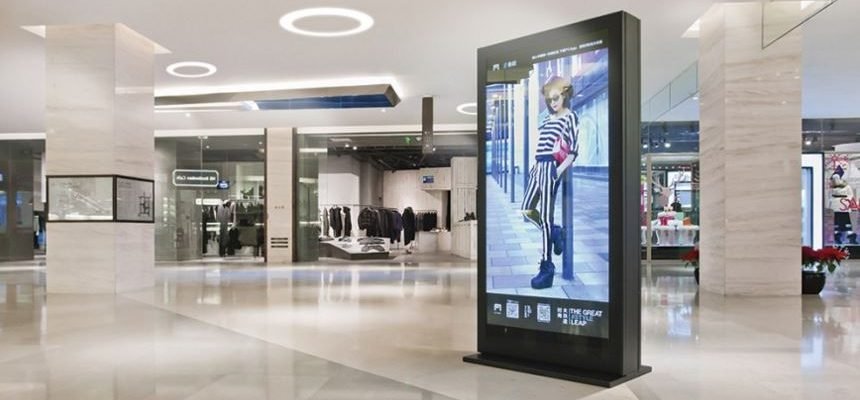Transforming Shopping Plazas with Digital Signage

The evolution of retail spaces has been constant over the decades, but the integration of technology has accelerated this change, offering new ways to enhance the shopper experience. Among these advancements, digital signage stands out as a transformative element for shopping plazas. It is not simply about transitioning from static to digital; it is about revolutionizing how shopping plazas communicate with their customers.
The Impact of Digital Signage on Retail Environments
Digital signage in shopping plazas is more than a digital replacement for traditional posters or banners. It is an interactive gateway that engages, informs, and entertains customers, thus impacting shopping behaviour and enhancing customer experience. By integrating vivid displays and interactive features, shopping centres can create an immersive environment that can influence purchasing decisions and strengthen brand loyalty.
Enhanced Customer Engagement
One of the most significant benefits of digital signage is its ability to capture the attention of passers-by with dynamic content. Whether it is video advertisements, social media feeds, or interactive maps, the diverse content options enable shopping plazas to keep content fresh and relevant. This real-time capability means that information can be updated instantaneously, allowing for the promotion of daily deals, flash sales, or events.
Wayfinding and Information
Digital signage also plays a crucial role in wayfinding solutions within shopping plazas. Large interactive directories provide visitors with a user-friendly way to locate stores, amenities, and services. These digital systems can reduce the sense of being overwhelmed that customers sometimes feel in large complexes, and directly contribute to an improved shopping experience.
Advertising and Brand Collaborations
For retailers, digital signage offers an unparalleled advertising medium. High-definition screens with eye-catching animations can showcase products and services in a way that static posters never could. Additionally, brands can collaborate with shopping plazas to create targeted campaigns that reach their desired audience effectively through strategic screen placement.
Case Studies: Digital Signage in Action
An excellent example of digital signage at work is the project carried out by JDS at the sunshine plaza. This case study reveals how a cohesive strategy that integrates digital displays can add value to the physical shopping space. Through large-format LED screens and interactive kiosks, sunshine plaza has been able to create a dynamic, modern environment for both shoppers and retailers.
Sunshine Plaza’s Success
The success of Sunshine Plaza digital signage is not just in the aesthetics or the novelty. It’s in the way the technology has been leveraged to support marketing objectives, provide valuable information, and create an ambiance that encourages more extended visits and increased spending. From the perspective of business metrics, this translates into tangible benefits such as higher foot traffic and sales.
Engaging Displays
Another sector within shopping plazas where digital signage has had a noticeable impact is the food court. Traditional static menu boards are being replaced by digital alternatives that offer flexibility in menu changes, promotional updates, and even nutritional information. The advantage of these digital menu boards lies in their ability to engage customers with vibrant imagery and influence their dining choices positively.
Creating the Future of Shopping Plazas
The continued integration of digital signage in shopping plazas is not just a trend; it’s a step towards the future of retail. As technology evolves, the potential to tie together online and offline experiences becomes increasingly realistic. Shopping plazas have the opportunity to use digital signage to build bridges between e-commerce and physical stores.
Interactive Experiences
Imagine screens that allow customers to browse online inventories, check stock in real-time, or even order products from the screen for home delivery. The potential for integrating augmented reality, where shoppers can “try on” clothes via a digital mirror, exemplifies how this technology can elevate the entire shopping experience.
Personalisation and Analytics
With advancements in data analytics and personalisation, digital signage can provide customised content based on the time of day, demographics, or even individual customer preferences. This level of personalisation can significantly enhance the shopping experience, making it feel more bespoke and attentive to individual needs.
Environmentally Conscious
On a broader scale, the adoption of digital signage is also an environmentally conscious decision. By reducing the need for printed materials, shopping plazas contribute to decreased paper waste and a lower carbon footprint, aligning with the growing consumer demand for sustainable practices.
Conclusion
As retailers and shopping plazas seek to maintain relevance in an increasingly digital world, adopting technologies like digital signage is not just advisable; it’s imperative. Used creatively, it can transform spaces, create new opportunities for engagement, and provide invaluable insights into customer behaviours.
For shopping plaza managers and retailers looking to stay ahead of the curve, the choice is clear. Digital signage represents a versatile platform that blends advertising, information, and aesthetic enhancement into one cohesive package. By harnessing its full potential, shopping plazas stand to redefine the retail experience, ensuring they continue to attract and retain discerning customers in an ever-competitive marketplace.
Also read: Hire a Personal Injury Lawyer Immediately
The journey into the future of retail is an exciting one, and digital signage is undoubtedly at the forefront of this evolution, ensuring that shopping plazas remain relevant, responsive, and robust in facing the challenges of the modern retail landscape.






